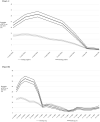Antibodies to SARS-CoV-2 and risk of past or future sick leave
- PMID: 33664279
- PMCID: PMC7933367
- DOI: 10.1038/s41598-021-84356-w
Antibodies to SARS-CoV-2 and risk of past or future sick leave
Abstract
The extent that antibodies to SARS-CoV-2 may protect against future virus-associated disease is unknown. We invited all employees (n = 15,300) at work at the Karolinska University Hospital, Stockholm, Sweden to participate in a study examining SARS-Cov-2 antibodies in relation to registered sick leave. For consenting 12,928 healthy hospital employees antibodies to SARS-CoV-2 could be determined and compared to participant sick leave records. Subjects with viral serum antibodies were not at excess risk for future sick leave (adjusted odds ratio (OR) controlling for age and sex: 0.85 [95% confidence interval (CI) (0.85 (0.43-1.68)]. By contrast, subjects with antibodies had an excess risk for sick leave in the weeks prior to testing [adjusted OR in multivariate analysis: 3.34 (2.98-3.74)]. Thus, presence of viral antibodies marks past disease and protection against excess risk of future disease. Knowledge of whether exposed subjects have had disease in the past or are at risk for future disease is essential for planning of control measures.Trial registration: First registered on 02/06/20, ClinicalTrials.gov NCT04411576.
Conflict of interest statement
The authors declare no competing interests.
Figures


References
Publication types
MeSH terms
Substances
Associated data
LinkOut - more resources
Full Text Sources
Other Literature Sources
Medical
Miscellaneous

